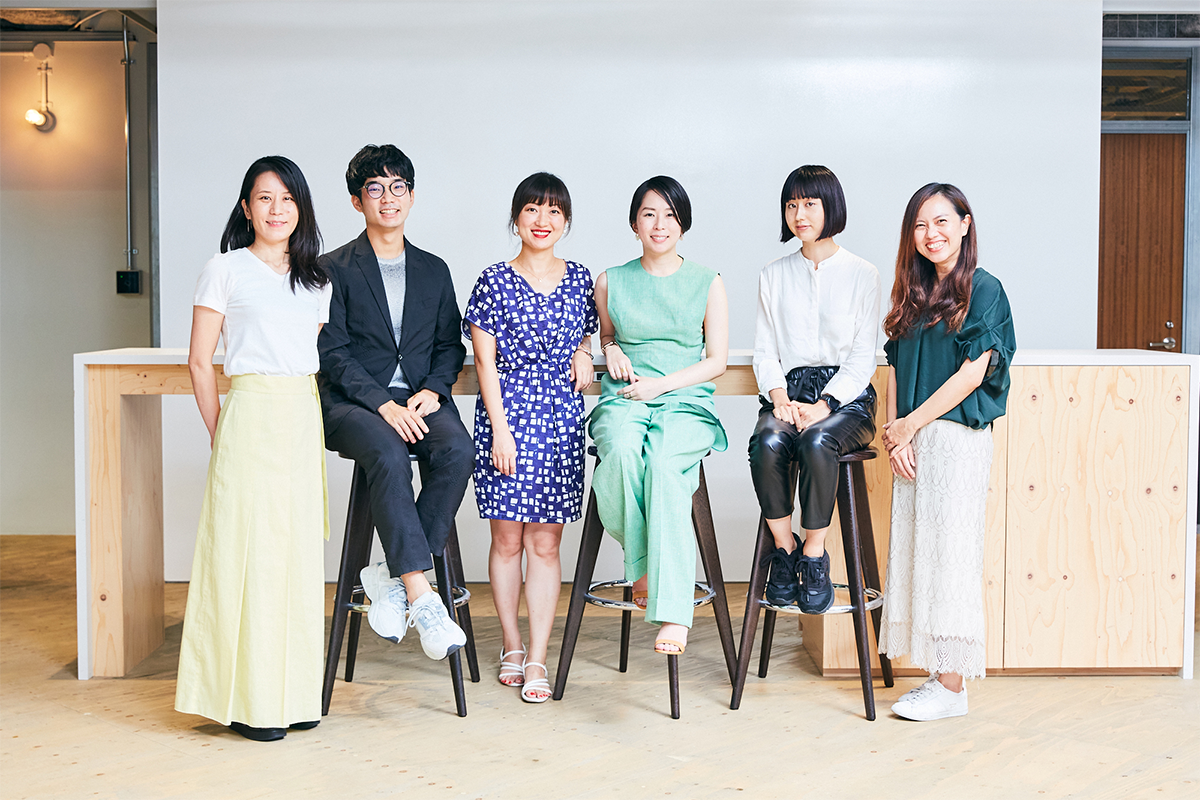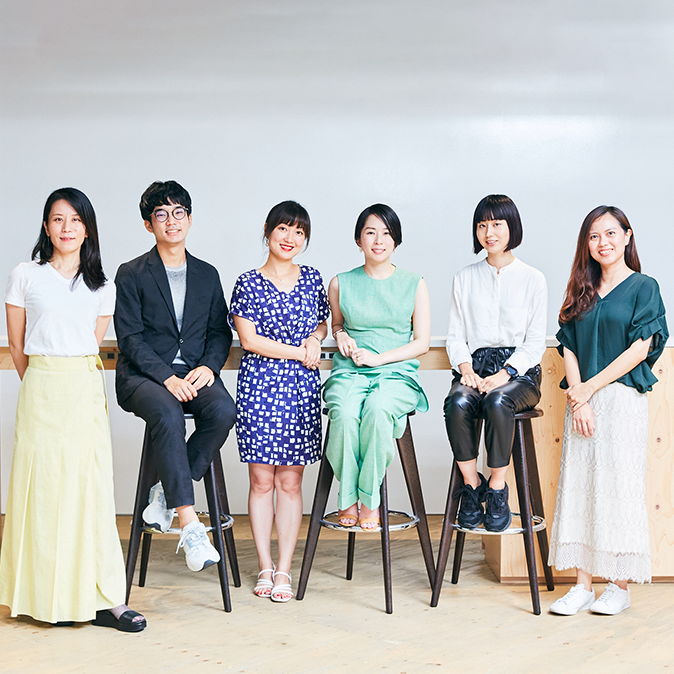- Viewpoints
What will next-generation ecommerce and customer relationship management bring?

COVID-19 has accelerated the digitalization of the user experience delivered by the world’s beauty brands. Where does the evolving beauty experience stand today? And what solutions is Hakuhodo uniquely positioned to offer in support of the digital transformation? Six professionals from different Hakuhodo Group units specializing in client marketing and business digitization have come together to meet the challenges of this new era. They’re each well versed in the issues facing clients and know how to take action to overcome them. Now they’re ready to work together as a single team on developing solutions for the rapidly evolving beauty industry. Their main focus: digital transformation (DX).
The second part of this two-part article examines the advent of the next generation in ecommerce and community-based customer relationship management (CRM). We’ll share several case studies from around the world. We’ll also describe what specifically you need to know as a brand to pull off the trick yourself. (Click here for Part 1.)
The cutting edge of the next generation in ecommerce
ABE:
In Part 1, we described how the beauty experience has rapidly evolved under the impact of COVID-19. We took a detailed look at three trends: product purchases and customer-service experiences with no offline component, the advent of the next generation in ecommerce, and community-based CRM. In Part 2, we’ll share several case studies from around the world of the next generation in ecommerce and community-based CRM.
NAN:
I’m going to describe several examples from overseas, where the next generation in ecommerce is already unfolding. First, a case in point of live shopping. With bricks-and-mortar stores being shut down, a lot more companies are now holding live shopping events as a means of delivering a more authentic shopping experience online. It’s also a way for them to reverse falling sales. At one department store in China, for example, employees livestream products on the store’s ecommerce platform, thus enticing people to shop online. In Thailand, a major cosmetics brand has partnered with a department store. They livestream on social media from the closed store, thus driving customers to its ecommerce site. Not only that, they’ll even purchase products on your behalf during the livestream. This proxy shopping service works as follows. The shopper makes an inquiry via their social media messaging app and sends an image of the product they want to buy. Customer support will then complete the purchase on their behalf. A payment link is sent to the shopper so they can pay for their purchase. This is a new shopping experience for Thai shoppers. In Japan, too, brands and department stores are starting to team up to hold live shopping events. The department store’s employees stream live on the store’s ecommerce platform. Live shopping events like these are likely to become ever more common.
Another trend that is emerging as the next generation of ecommerce unfolds is social commerce. Customer-to-customer (C2C) social commerce already enjoys a considerable presence in Southeast Asia. Now business-to-customer (B2C) social commerce is poised to spread across the globe. Western social media companies are being closely watched as they develop new features with social commerce in mind. One photo sharing platform has launched a shop feature in the United States. This lets you complete purchases, including payment, within the app. It’s eventually expected to be linked to a payment service offered by the same social media conglomerate. Then you’ll be able complete the entire purchase process, including payment, on the same social media platform.

Meanwhile a certain messaging service has launched an ecommerce platform in Thailand. Campaign information is sent out from the brand’s official account, and you can make purchases right from the message window. FMCG brands and even automakers are now taking advantage of this online shopping function. There’s already a feature that lets you make a down payment on a car. The entry of social media platforms into the ecommerce market will likely attract increasing attention.
JUDY:
In China, live shopping events featuring key opinion leaders (KOLs) are all the rage. These influencers showcase products that match the season or the latest trends: for example, makeup items that don’t smudge under your mask, even in summer, or popular new lipstick colors. But that’s not all. They also exchange comments with their fans and share information on subjects other than cosmetics, like what restaurants they’ve been to lately. They hold live shopping events virtually every day. Their entire lifestyle, for which they’re admired, is on display, and they talk about the products as a natural part of it. People are therefore more likely to want to buy them.
The combination of employee-generated content and live shopping mentioned in Part 1 is also becoming more common. With stores being shut down because of COVID-19, there’s been a surge in live shopping events since 2020, and these feature not just KOLs but also retail staff who work for a particular brand. Livestreaming from stores is booming too. The online and offline worlds are merging.
ABE:
Live shopping is more popular in China than anywhere else in the world. YouTubers and KOLs are treated just like stars. They decide which items to showcase themselves. The amount they sell is huge, so they’re often used to boost brand awareness. The featured products sometimes instantly sell out online. The impact is similar to that of being featured on an infotainment program in Japan.
What’s more, in China, live shopping events are directly linked to an online store, which you can check out as you watch the livestream. You can get online advice and buy the product there and then. It’ll be delivered the same day. Now that’s a frictionless shopping experience.
The dominant pattern in Japan is this. The streamed content is designed to be informative. It showcases the product and tells you how to use it. Viewers are then told where to go to buy it by displaying a purchase link on the social media site. But even in the West—and that includes Japan—considerable progress has been made in implementing functionalities similar to those in China: livestreaming from your brand’s own site and letting shoppers buy the product from your online store as they watch. One day it will, I believe, become standard practice to complete the entire process seamlessly online, from content delivery to payment.

• The challenges facing live shopping in Japan, and how to overcome them
YOKOI:
We’re now working on live shopping events ourselves, and I believe we have several challenges to overcome. Livestreams by influencers on Instagram make quite an impact. But rival brands ask them to do events as well, so it sometimes happens that an influencer recommends Company A’s products one week and Company B’s products the next. Influencers are naturally concerned about losing credibility, so they’re likely to become less inclined to agree indiscriminately to every request. That creates a dilemma. Live shopping events are certainly effective, but it’s not easy to hold them regularly.

One type of live shopping activation could be implemented regularly: livestreams starring your own employees. There are two challenges in that regard. How do you find charismatic salespeople with a knack for livestreaming? And how do you create a script for the commentary to accompany the live shopping event? Our expertise in the direct marketing field producing home shopping shows and direct-response infomercials should come in handy for the latter. In the world of direct marketing, techniques for making people eager to buy your product within the scope of a 30-second to 30-minute broadcast have been scientifically researched based on actual response data. Draw up a script based on that model, then get your staff to perform it, and there’s a good chance your activation will be highly effective.
MIYOSHI:
Then there’s social commerce. More and more brands these days implement shopping functions in social media that are linked to their online store. What used to be a tool for boosting engagement by making posts, and for casually connecting with customers, is evolving into a direct pathway to online shopping. Our group’s social media team already has a lot of experience helping clients set up accounts, craft posts, and analyze data to see whether people have accessed their online store. So I think we can definitely be of assistance.
• Private traffic: The next big thing in marketing!?
JUDY:
Let me share an example of the next generation in CRM from China. It’s called private traffic. This marketing concept is now making waves in China, and it’s beginning to attract attention in the West as the next generation in community-based CRM. Private traffic can be defined concisely as follows. It’s a marketing technique whereby, once someone engages with your brand, they’re onboarded to your official messaging app (WeChat) account. It’s designed to develop them as customers and convert them to buyers, repeat buyers, and then mouthpieces for your brand, yet keep down advertising costs.
There are multiple touchpoints for private traffic. A typical example is the QR code on the product package, from which you are taken to the brand’s official messaging app account. When you follow the brand’s account, you receive a constant stream of information in the form of an email newsletter or whatever. If you friend the online customer support account, in addition to regular updates you also receive promotional coupons, and any questions you have will be answered.
You can also join a chat group. This functions as a brand community, allowing you to engage in various forms of communication with other users.
If you see a product you’d like to buy in the newsletter, or learn about one from your chat group or the customer support account, the appropriate link can be found in an instant. All it takes is a single click to sign up and purchase the item at the brand’s online store—accessed via a WeChat mini program. One reason this arrangement works so well in China is WeChat’s colossal user base. Everybody in China uses it. People spend hours a day on it. In Japan a multitude of smartphone payment services compete with each other. China is different. There, almost everyone uses one of two payment services, Alipay or WeChat Pay. They both have a huge market share. So there’s no difference in the level of service users enjoy.

One local Chinese brand has skillfully leveraged private traffic to achieve rapid growth. And it’s a newcomer to boot, having only appeared on the scene in 2017. A certain drugstore, meanwhile, offers a service called cloud shopping. Each of its offline stores has a mirror shopping site on the messaging app WeChat, created using a WeChat mini program. Users register the mirror site of the offline store closest to where they are at the time. They can add the store’s salespeople to their friends list as online customer support. When they order something, it arrives within an hour.
We predict that the concept of private traffic will spread to Japan and around the world. We hope to be able to offer the optimal solutions for Japan while studying the Chinese model.
• What you need to deliver the ultimate brand experience—and build the ultimate brand community
YOKOI:
There are two keys to implementing community-based CRM in Japan. First, you need to integrate online and offline customer data. If the two aren’t linked, you won’t always know when customers made purchases and through which channels. Integrating online and offline data is also important to implementing one-to-one messaging after a purchase and determining the actual level of repeat purchases.
The second key is what medium to build your brand community in. Social media appears to be growing in importance alongside the time-honored email newsletter. We believe that it’s more effective to locate your communications hub in a medium that your target audience uses regularly and where it spends lots of time. Some brands use social media for the purpose of lead nurturing: turning non-customers into customers. But that’s not all you can do on social media. It can also be useful at the next phase, turning customers into repeaters. You can share tricks to using the product, say, or lifestyle tips.
ABE:
Some American brands, for example, set up a private, locked account on social media. Fans have to apply to join, and they can only get in if the brand approves. It’s a completely closed space, where the brand moderates the conversation and encourages users to talk to each other. Providing such a forum for fans results in greater liking and trust for the brand. So there are lots of other approaches besides private traffic. At any rate, we look forward to taking on this new challenge with our clients: how best to design and run a brand community.
YOKOI:
Judging from the beauty startups you see abroad, I’d say that it’s important to have a founder who’s a colorful character and epitomizes the brand values.
MIYOSHI:
It’s true that, in the apparel industry as well, brands have emerged lately that owe their magnetism to the star quality of their founder. But it’s risky, of course, to be overdependent on a single individual. That’s why it’s important to take steps like, for instance, improving the overall quality of your online customer support. One of the companies of the Hakuhodo Product’s Group is expert in designing training programs for retail sales staff and creating systems for evaluating them. So that’s an area we’ve got covered.

ABE:
This two-part article has examined a broad range of emerging trends in the beauty industry. New experiences have become available at many different touchpoints. I have a hunch that shopping will soon be more fun than ever. But if adopting the latest approach becomes an end in its own right, that might alienate existing customers. It could detract from the original brand experience. The brand and the agency—that’s us—need to work together on designing the optimum solution for that particular brand. We should never lose sight of what kind of experience we want to deliver, what kind of customer journey we want to map out.
For example, for all the talk of taking customer service online, a lot of companies might end up concluding, “In the end it’s easier to get our message across to our current customers by phone.” The Hakuhodo Group is committed to helping clients make the digital transformation that’s genuinely right for them. We size up your situation and design a customized solution just for you.

CMP Development Division, Hakuhodo Inc.

Global CMP Development Department 1, CMP Development Division, Hakuhodo Inc.

Global CMP Development Department 1, CMP Development Division, Hakuhodo Inc.

CRM Design Unit, Data Business Design Division, Hakuhodo Product’s Inc.

Data Business Development Unit, Data Business Design Division, Hakuhodo Product’s Inc.













